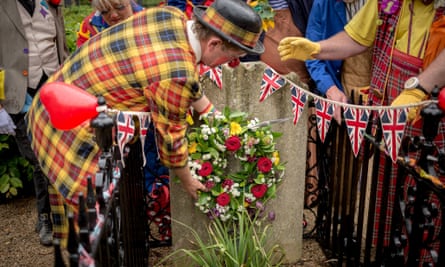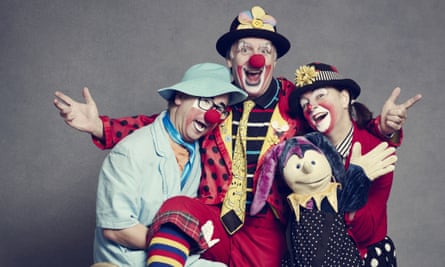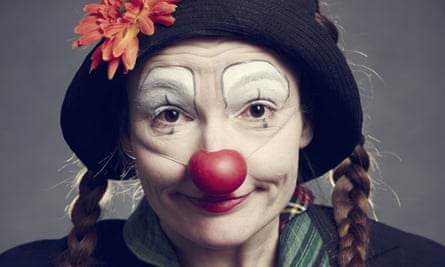Mattie Faint has been a professional clown since he was 17 when, as a theatre student up from Plymouth, he got a gig as a grease-painted human signpost for a puppet show in London. That was 44 years ago. For the past two decades he has been a “giggle doctor”, mostly at Great Ormond Street Hospital, four-hour shifts on the cancer wards, never out of character. He is the secretary of Clowns International, the accreditation body of clowning, and the co-curator of the Clown Museum, a cramped one-room trove of all things red-nose that was once the vestry of a church in Hackney. He also organises the annual clown memorial service for the original Joey, Joseph Grimaldi, the legendary British Victorian entertainer, on the first Sunday in February, and he tends Grimaldi’s grave in the eponymous park off Pentonville Road in Islington, all year round.
When Faint talks to me about his clowning, he occasionally adopts the pantomime squeak of his painted alter ego. “It’s a very funny business being a clown these days,” he squeaks at one point. He can’t help feeling the profession is changing, and probably for the worst.
He sits at a table in his museum, beside a row of big clown boots, sipping black coffee. “I had a call this morning,” he says, by way of example, “somebody wanted me for an hour, upstairs in a pub, to entertain the kids while the adults had a good time downstairs. This woman called saying ‘Do you just do clown or do you do other things?’”
Faint said he just did clown.
“Do you do Frozen?” the woman asked. Faint, adopting the cockney drawl he reserves for grown-ups who don’t get it, winces a bit at the idea. “That’s what they all say now: ‘He really wants Frozen’; ‘Do you do Frozen?’”

Faint explained that he did not do Frozen, and he explained that if the woman were to find a person who did do Frozen then Frozen was probably all they did; there wouldn’t be a magic show or games or balloons or pratfalls or whatever. The hour above the pub might drag a little. The woman said she would have a think.
“A lot of people are doing pirates and fairies now,” he says, with a slightly heavy heart. “That’s a wider market. There was a time when I’d do four or five shows a weekend. Not now.”
Many things have affected the clowning business, not least the recession: parents don’t want to fork out. The golden age of big-top > clowning has gone with the demise of the big touring circus. The skills aren’t being passed on any more. But it’s more than that. Children are frightened of clowns; adults, too. A University of Sheffield study of 250 children for a report on hospital design suggested children find clown motifs “frightening and unknowable”.
In 2006 Bestival music festival had to change its clown fancy-dress theme after ticket holders complained; America’s famous “clown college” has closed down. Coulrophobia, a word only coined in the 1980s, took hold after 1990 film of Stephen King’s novel It, featuring the sadistic clown Pennywise, who preyed on children (King’s novel borrowed some elements from the real-life story of serial killer John Wayne Gacy, who had performed as Pogo the Clown). The stereotype has subsequently been mined by numerous low-budget films, and lately fuelled by a series of terrifying YouTube clips of ghoulish clown “pranks” in underground carparks and on deserted roads.
All of which, Faint admits, can make it a tough audience for clowns these days. “The internet is a wonderful thing, but children can access it too easily and children are scared half to death by what they see. I’ve walked in to some hospital rooms and they’d go: ‘Aaagh, keep away from us!’ The parent would explain that ‘my child saw a bit of It on his computer when he was five and it scarred him for life…’”
The hysteria of stranger danger has exacerbated the situation. “Jimmy Savile really hasn’t helped,” Faint says.
“But the big change I noticed happened when poor Jamie Bulger was murdered in 1993. I had been working in a shopping centre the week before, and the weekend after, the change was drastic. I was in a “fun area” with bouncy castles. And the idea was you left your children and went shopping. But that weekend, and afterwards, the parents would not go, they just all stayed at the back, watching me.”

Faint – who worked in professional theatre (he was the original stage manager of The Rocky Horror Show) – was in at the beginning of the Theodora charity, which provides clowns for children’s hospitals, but he gave it up last year. The style has changed, he says. “They have 30 clowns now, working in 21 hospitals, but the emphasis has become very feminine. They only have four men, I think. Everyone is CRB-checked and everything, but it is almost as if children are not allowed to be near adults at all any more.”
Faint has a library of clown books in the museum, the best of them, a life of Joseph Grimaldi, was written by Andrew Stott, professor of English at the University of Buffalo, and historian of the origins of British clown culture. Stott suggests that the darker archetypes of clowns were there from the start. “The idea of clowns as children’s entertainers has actually only been a very small and recent part of the history of clowning,” Stott says, by phone. Prior to that, in the Regency and Victorian periods clowning and pantomime was for an adult audience. “Grimaldi is the kind of spiritual father of today’s clowns, but I think he would have likened himself more to Chaplin or Keaton – somebody like that.”
The idea of clowns and comedy shadowed by mortal fears goes back way beyond that, of course, but reached a different pitch with Grimaldi, Stott suggests. “What made Grimaldi himself so fascinating though was that he did always actually seem close to death. He was constantly on the verge of breaking his neck on stage. He performed as a child with his incredibly morbid father, and suffered manic depression throughout his life. His son, also a clown, was an alcoholic and a very destructive character. Grimaldi makes a cameo appearance in Dickens’s Pickwick Papers and that is really the first time when we see the clown as a horrific figure. The first time we see through the painted smile to something more desolate…”
After that, Stott suggests, there was always something discomforting about the person behind the mask. In more God-fearing times, perhaps, the idea of children being exposed to both anxiety and comedy was more palatable to parents. Most would think twice now.
“We can’t help having big questions as to why an adult man would dress up like that,” Stott says. “There is some kind of subterfuge going on, some ulterior motive, and we associate adults dressing up with sexual fetish. Who nowadays would put their child in close proximity with people whose motivations you don’t quite understand?”
Can he see a way for clowns reinventing themselves in a more benign guise, I wonder.

“I think it’s culturally exhausted, really. I think it is a figure of the horror menagerie, like Frankenstein’s monster or vampires, and I think that’s fine. We don’t need to sustain clowning if clowning has become anachronistic. But then I don’t make my living clowning.”
Many of those who do gather for an annual meeting in Haggerston, northeast London, where they celebrate the life of Grimaldi. Some clowns have arrived in costume. A few are applying noses and make-up and catching up with old friends. Most, like Faint, have been coming to this service for longer than they care to remember. Talking to them, I get a sense of the transformation that occurs when their smiles are painted on. Several are shy before getting changed; all turn up the volume in character.
There is, too, something of a sense that they are growing old together. Nine of their number died this year and will be remembered in the church service. There are only a couple of clowns under 25 in the group. One, Helen Champion (Zenden the Clown), had been painting clowns as part of her fine art degree at Goldsmith’s and had gone native. The other, Jonathan Arthurs, 16, tells me how becoming a clown was a form of aversion therapy. His parents’ house in Herne Bay, Kent, was over the road from that of another clown here, Carol Bosworth, aka Pip. As a child he lived in mortal fear of the clown painted on the side of her van. When he was finally persuaded to watch her apply her make-up he became a convert.
The clowns parade over to the packed church and assemble in the front pews, squirting lapel flowers and sitting on whoopee cushions. Faint opens the service with a clownish poem, praising the gift of laughter. Nine candles are brought forward by children for the clowns who have died, and a 10th for the unknown clown. Afterwards there is a floor show for the children, then Faint leads a party up to the Clown Museum. People ask him often, he says: “Are you a sad clown?”
Is he?
“No, but it has many down moments. You buzz buzz buzz, and you go back out the door into reality. It hits home.” Sometimes, he says, literally. “Recently I did a kids’ party in a house, I’m changing back into my clothes upstairs, the mum is at the bottom of the stairs giving out party bags and when I come down with my suitcase she grabs me and starts shaking me by the throat. ‘Who are you? What you doing in my house?’ She thought I was a burglar. ‘I’m the clown!’ I gasped.”
Have the kids changed, I wonder, in the 44 years he has been trying to make them laugh.
“There is still the age of innocence,” he suggests. “Four- to six-year-olds haven’t changed much, but when they get older they are a bit more sarcastic. You see a few extremes. I did a party recently, all the mums in the kitchen smoking. I’m standing with the kids in the front room and I say: ‘Who’s the birthday boy?’ and they say: ‘He’s not here, he is upstairs on his computer.’ I go up to his room and say: ‘Come down, we are going to have a great time!’ I’m in full clown outfit, but he doesn’t look up. And I try again. And he looks at me and says, ‘Why don’t you just fuck off!’ He was six that day.”
Faint hasn’t given up on clowning now he has stopped his giggle doctoring, but plans to take it into new areas. He wants to do something with road safety. “Sort of Laurel and Hardy meets The Blues Brothers”. Last year he went to Australia, travelled 3,500 miles with clown doctors working with dementia patients in care homes. He believes reports of the demise of clowns are greatly exaggerated. “Clowns won’t go away,” he says, with a laugh. “We probably just need to diversify.”

Comments (…)
Sign in or create your Guardian account to join the discussion